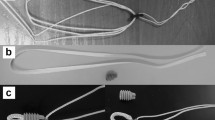Abstract
Purpose
Cortical suspensory devices are routinely used for femoral side fixation of soft tissue graft in anterior cruciate ligament (ACL) reconstruction. The purpose of this study was to evaluate the biomechanical properties of a new adjustable loop device (GraftMax®) compared with established devices (EndoButton® and TightRope®) in ACL reconstruction and to investigate whether knotting the free end of TightRope could improve biomechanical properties.
Methods
The three cortical suspensory devices (GraftMax® Button; Conmed, EndoButton® CL; Smith & Nephew, and TightRope® RT; Arthrex) were tested under cyclic load (50–250 N for 1000 cycles) and pull-to-failure conditions at 50 mm/h in a device-only setup using a tensile testing machine. The TightRope was additionally tested with its free suture ends knotted. The statistical analyses were done with one-way analysis of variance (ANOVA) and post hoc Tukey HSD tests.
Results
There are significant differences in the load-to-failure among the devices. The EndoButton showed the highest mean failure load at 1204.7 N compared to other devices (GraftMax (914.2 N), knotted TightRope (868.1 N) and TightRope (800.1 N) (p < 0.001). The mean total displacement after 1000 cycles was 0.76 mm, 2.11 mm, 1.56 mm and 1.38 mm for the EndoButton, GraftMax, TightRope, and knotted TightRope, respectively. The EndoButton showed significantly better properties than both the GraftMax (p = 0.000) and the TightRope (p = 0.020) but not the knotted TightRope (p = n.s.) in total displacement. However, there was no significant difference between the TightRope and GraftMax (p = n.s.).
Conclusion
The fixed loop (EndoButton) showed significantly better mechanical properties in failure load and displacement than TightRope or GraftMax in this biomechanical study. However, the mechanical properties of the GraftMax is comparable to the TightRope. Moreover, the knotting of TightRope improved mechanical properties in total displacement more than TightRope, but not in failure load.
Clinical relevance
The biomechanical properties of the GraftMax are comparable to the TightRope. The TightRope, when knotted, shows an improvement both in load to failure and cyclic displacement, though the differences are not significant.




Similar content being viewed by others
Change history
23 February 2018
The original publication of this paper contains mistakes. The first author name "Jin Cheng" is changed to "Cheng Jin ".
References
Kilinc BE, Kara A, Oc Y, Celik H, Camur S, Bilgin E, Erten YT, Sahinkaya T, Eren OT (2016) Transtibial vs anatomical single bundle technique for anterior cruciate ligament reconstruction: a retrospective cohort study. Int J Surg 29:62–69
Nyland J, Mattocks A, Kibbe S, Kalloub A, Greene JW, Caborn DN (2016) Anterior cruciate ligament reconstruction, rehabilitation, and return to play: 2015 update. Open Access J Sports Med 24(7):21–32
Ahmad CS, Gardner TR, Groh M, Arnouk J, Levine WN (2004) Mechanical properties of soft tissue femoral fixation devices for anterior cruciate ligament reconstruction. Am J Sports Med 32:635–640
Kim KI, Lee SH, Bae C, Bae SH (2017) Three-dimensional reconstruction computed tomography evaluation of the tunnel location and angle in anatomic single-bundle anterior cruciate ligament reconstruction: a comparison of the anteromedial portal and outside-in techniques. Knee Surg Relat Res 29:11–18
Barrow AE, Pilia M, Guda T, Kadrmas WR, Burns TC (2014) Femoral suspension devices for anterior cruciate ligament reconstruction: do adjustable loops lengthen? Am J Sports Med 42:343–349
Petre BM, Smith SD, Jansson KS et al (2013) Femoral cortical suspension devices for soft tissue anterior cruciate ligament reconstruction: a comparative biomechanical study. Am J Sports Med 41:416–422
Johnson JS, Smith SD, LaPrade CM, Turnbull TL, LaPrade RF, Wijdicks CA (2015) A biomechanical comparison of femoral cortical suspension devices for soft tissue anterior cruciate ligament reconstruction under high loads. Am J Sports Med 43:154–160
Gelber PE (2015) A guide to mastering the Graftmax Button adjustable cortical fixation device-An examination of surgical learnings during the first six months of clinical usage. Conmed Corporation. http://www.conmed.com/en/products/orthopedics/knee/ligament-reconstruction/fixation/graftmax-button-adjustable-cortical-fixation-device. Accessed 22 April 2017
Born TR, Biercevicz AM, Koruprolu SC, Paller D, Spenciner D, Fadale PD (2016) Biomechanical and computed tomography analysis of adjustable femoral cortical fixation devices for anterior Cruciate ligament reconstruction in a cadaveric human knee model. Arthroscopy 32:253–261
Eguchi A, Ochi M, Adachi N, Deie M, Nakamae A, Usman MA (2014) Mechanical properties of suspensory fixation devices for anterior cruciate ligament reconstruction: comparison of fixed-length loop device versus the adjustable-length loop device. Knee 21:743–748
Daniel DM, Stone ML, Sachs R, Malcom L (1985) Instrumented measurement of anterior knee laxity in patients with acute anterior cruciate ligament disruption. Am J Sports Med 13:401–407
Funding
There was no funding related to this study.
Author information
Authors and Affiliations
Corresponding author
Ethics declarations
Conflict of interest
The authors declare that we have no potential conflict of interest.
Rights and permissions
About this article
Cite this article
Cheng, J., Paluvadi, S.V., Lee, S. et al. Biomechanical comparisons of current suspensory fixation devices for anterior cruciate ligament reconstruction. International Orthopaedics (SICOT) 42, 1291–1296 (2018). https://doi.org/10.1007/s00264-018-3780-7
Received:
Accepted:
Published:
Issue Date:
DOI: https://doi.org/10.1007/s00264-018-3780-7




